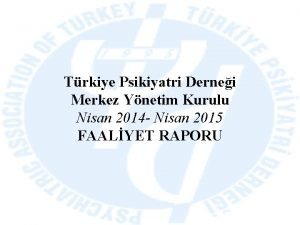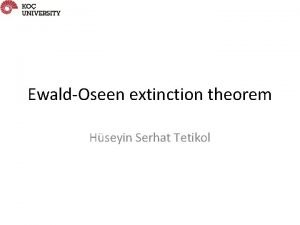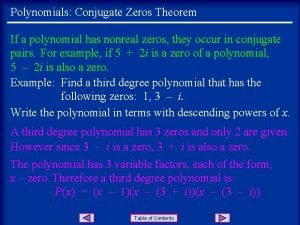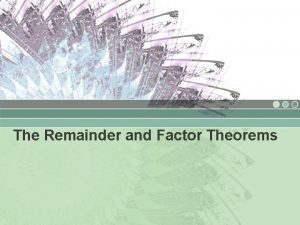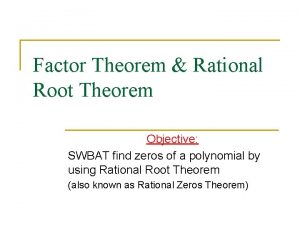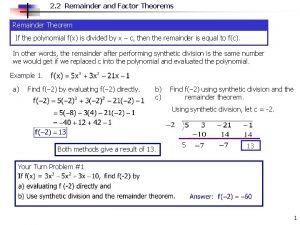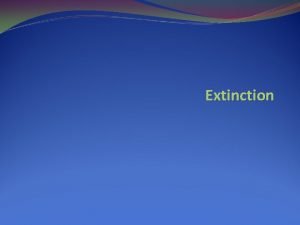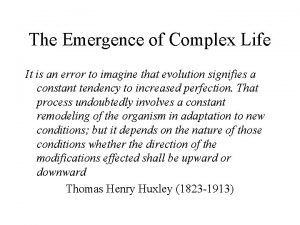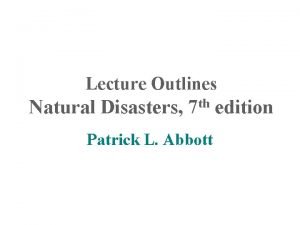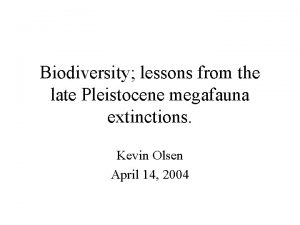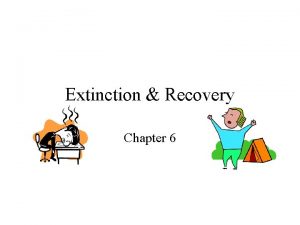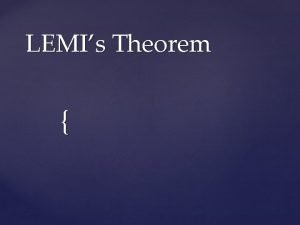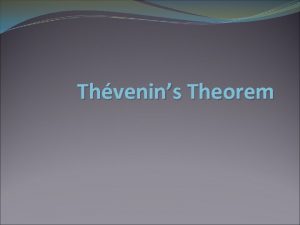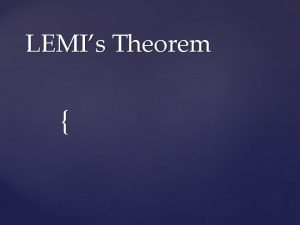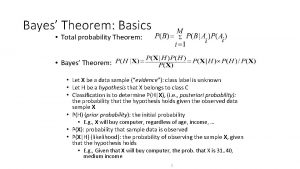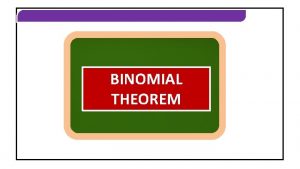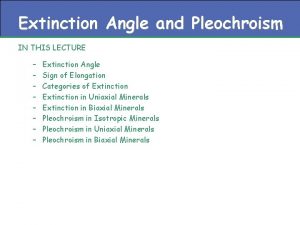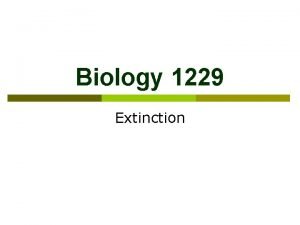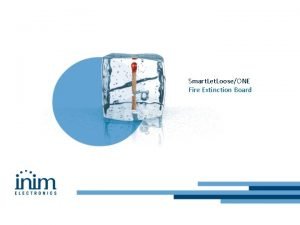EwaldOseen extinction theorem Hseyin Serhat Tetikol EwaldOseen extinction



















![References • [1] Fearn, H. , James, D. F. , Milonni, P. W. (1996). References • [1] Fearn, H. , James, D. F. , Milonni, P. W. (1996).](https://slidetodoc.com/presentation_image_h/fe50da7772670059b5a9f3e8da104804/image-20.jpg)
- Slides: 20

Ewald-Oseen extinction theorem Hüseyin Serhat Tetikol

Ewald-Oseen extinction theorem • An electromagnetic plane wave is incident on a dielectric-vacuum interface. As a result, a reflected wave and a transmitted wave are generated. We can easily calculate the properties (amplitudes, propagation directions, speeds) of these waves using Maxwell’s equations. 2

Ewald-Oseen extinction theorem • The reflection occurs at the same angle as the angle of incidence. • Transmitted wave travels at a different angle and at a slower speed (c/n). • Both the transmitted and the reflected waves are still plane waves. These are remarkable conclusions! 3

Ewald-Oseen extinction theorem • How on earth do we get such a neat and simple result? The dielectric is a collection of atoms or molecules whose individual behaviours are much more complex than these results. Do these atoms or molecules conspire to give us unexpectedly simple results, or is there something else at play? Many dipoles ? ? Much more Simple complex behaviour 4

Ewald-Oseen extinction theorem • The conventional way of solving this problem does not answer these questions because it does not really explain how the dielectric behaves at the microscopic level. It assumes that the medium has a “macroscopic” description and follows from there. 5

Ewald-Oseen extinction theorem • This is where Ewald-Oseen extinction theorem comes in. It replaces the dielectric with a collection of particles which act as electric dipoles, as shown. There is no media anymore: The entire space is vacuum, half of which is occupied by the dipoles. This picture is reasonable as we know that materials are made of atoms/molecules that more or less act like electric dipoles. Blue dots are the dipoles. Red circles are their radiation. 6

Ewald-Oseen extinction theorem • The incident wave travels at the speed of light c everywhere, since there is no media but only vacuum. • The indicent wave does not change direction, for the same reason. • The incident wave excites the dipoles, and the total field at any point is given by the summation of the incident field and the fields generated by the dipoles (which also travel at the speed of light). Blue dots are the dipoles. Red circles are their radiation. 7

Ewald-Oseen extinction theorem • The theorem shows that the summation of the incident field and the fields generated by the dipoles magically give one plane wave in the upper half-space and one in the lower half-space: The former seems to travel slower and in a different direction (the transmitted wave), the latter travels with the same speed c, reflected by the angle of incidence. Blue dots are the dipoles. Red circles are their radiation. 8

Ewald-Oseen extinction theorem Let’s define the problem • The incident wave: • The fields generated by the dipoles: • The total field: Blue dots are the dipoles. Red circles are their radiation. 9

Ewald-Oseen extinction theorem • The field generated by a single dipole: 10

Ewald-Oseen extinction theorem • What is left is to find by summing the fields of all dipoles. A dipole will be polarized due to the total electric field acting on it. In our case, the total field acting on a dipole is the incident electric field plus the fields generated by all the other dipoles! This is, indeed, the same as the total electric field we defined previously. We can assume that the dipoles form a continuous distribution in z > 0 region. The dipole moment of a unit volume will simply be the polarization density of the medium. Blue dots are the dipoles. Red circles are their radiation. 11

Ewald-Oseen extinction theorem • We put p into E. Then multiply with to get the amplitude and integrate over the upper half-space. Blue dots are the dipoles. Red circles are their radiation. 12

Ewald-Oseen extinction theorem • Evaluating the integral over x an y, • Integrating over x and y gives us a slice of dipoles perpendicular to the z axis. • This slice radiates plane waves (due to the polarizing field acting on it) in both positive and negative z directions. • Each slice radiates a plane wave with a different magnitude and phase, and all this integral does is add these plane waves coherently. Blue dots are the dipoles. Red circles are their radiation. 13

Ewald-Oseen extinction theorem • We can also write the total field as, or Blue dots are the dipoles. Red circles are their radiation. 14

Ewald-Oseen extinction theorem • The first integral (above) from 0 to z represent forward propagating waves and originate from the dipole layers below z. • The second integral represent backward propagating waves and originate from layers above z. Forward and backward propagating waves originating from different layers and contributing the total field at the observation layer. 15

Ewald-Oseen extinction theorem • Using solution, we get as the trial • This result indicates and which gives and 16

Ewald-Oseen extinction theorem • We can also find which is exactly what we were looking for. The fields generated by the dipoles exactly cancel the incident field, leaving behind a wave that propagates at a speed of c/n! 17

Ewald-Oseen extinction theorem • A similar derivation leads to the reflected field: 18

Ewald-Oseen extinction theorem • A few scientists who initially got theorem wrong: – – – – Max Born Emil Wolf John David Jackson Paul Peter Ewald Carl Wilhelm Oseen Melvin Lax Leon Rosenfeld Victor Frederick Weisskopf 19
![References 1 Fearn H James D F Milonni P W 1996 References • [1] Fearn, H. , James, D. F. , Milonni, P. W. (1996).](https://slidetodoc.com/presentation_image_h/fe50da7772670059b5a9f3e8da104804/image-20.jpg)
References • [1] Fearn, H. , James, D. F. , Milonni, P. W. (1996). Microscopic approach to reflection, transmission, and the Ewald-Oseen extinction theorem. American Journal of Physics, 64(8), 986 -994. • [2] Mansuripur, M. (1998). The Ewald. Oseen Extinction Theorem. Optics and Photonics News, 9(8), 50 -55. • [3] Jackson, J. D. , Jackson, J. D. (1962). Classical electrodynamics (Vol. 3). New York etc. : Wiley. • [4] Griffiths, D. J. , Reed College. (1999). Introduction to electrodynamics (Vol. 3). Upper Saddle River, NJ: Prentice Hall. • [5] Pattanayak, D. N. , Wolf, E. (1972). General form and a new interpretation of the Ewald-Oseen extinction theorem. Optics Communications, 6(3), 217 -220. 20
 Current background extinction rate
Current background extinction rate Esra eron serhat akın
Esra eron serhat akın Serhat galimane
Serhat galimane Serhat çıtak ekibi
Serhat çıtak ekibi Bölgesel yenilik sistemleri
Bölgesel yenilik sistemleri Ebrar alya demirbilek
Ebrar alya demirbilek Hışman çizik
Hışman çizik Serhat turhan kimdir
Serhat turhan kimdir Stokes vs green's theorem
Stokes vs green's theorem Ewald oseen extinction theorem
Ewald oseen extinction theorem Conjugate zeroes theorem
Conjugate zeroes theorem Remainder therom
Remainder therom Linear factors theorem and conjugate zeros theorem
Linear factors theorem and conjugate zeros theorem Rational zero theorm
Rational zero theorm Polynomials theorem
Polynomials theorem Factor theorem and remainder theorem
Factor theorem and remainder theorem Withholding reinforcement for a target response
Withholding reinforcement for a target response Phaneozoic
Phaneozoic Quaternary extinction
Quaternary extinction Extirpation vs extinction
Extirpation vs extinction Simultaneous extinction
Simultaneous extinction



